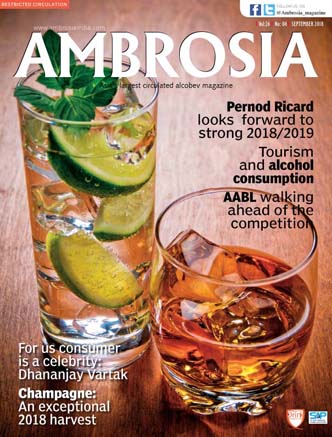
Author Archives: Bhavya Desai
AMB OCY 2018 issue
AABL walking ahead of the competition
It all began in Madhya Pradesh when Associated Alcohols & Breweries Limited (AABL) was incorporated in 1989. The company was set up by its founder Chairman – the Late Bhagwati Prasad Kedia and has grown to become one of the largest distilleries in India today and the flagship company of the Associated Kedia Group, a `3000 million liquor conglomerate with interests in liquor manufacturing and bottling.The Group is in liquor trade since the last four decades and in an exclusive interview with Ambrosia,the management dwells on its history and the road ahead.

Anshuman Kedia and Anand Kedia
Growing over a period of four decade is one thing and also ensuring that you stay ahead of the curve is another. AABL till date produces 4 million cases of country liquor per annum and has cornered a market share of approximately 20-22% in Madhya Pradesh. “We have come a long way since 1989,” says Anand Kedia, Chairman of AABL adding that the company’s journey started from trading in molasses, country liquor and IMFL to now becoming a premium brand manufacturer. “In 1986 we applied for a license and by 1989 we started manufacturing quality Extra Neutral Alcohol (ENA). We soon transitioned from molasses to grain based ethanol and from day one of Diageo’s existence in India we have been manufacturing products for them. Some of these include Gilbey’s, Triple distilled vodka namely Smirnoff, Black & White, Vat 69 and Black Dog,” says Kedia. Our USP in the industry and the market is best quality in ENA and we have been supplying ENA to companies like USL, Pernod, ABD among others. We also supply ENA to other states and their demand for the same is through the roof says Anand. Their ENA manufacturing capacity has now increased from 31 million litres to 45 million litres with AABL having the licenses to produce upto 90 million litres.
Aspri Spirits launch Tito’s Handmade Vodka in India
Tito’s hand made vodka has become a successful brand and has catapulted its founder Bert Beveridge into the Forbes top 400 richest men in the world. John McDonnell, Managing Director International, Fifth Generation Inc, shares some of the reasons the brand has become a sensation.

John McDonnell
In 1995, Bert “Tito” Beveridge launched Tito’s handmade vodka with a philosophy “I was raised that if you are going to do something, do it right, do it better than anyone else, and charge a reasonable price.” -Tito. His philosophy has paid handsome dividends and it’s worth billions now, with $190 million in sales already and around 58 million bottles sold in 2017. To put it simply, in a 52-week year, means more than 1 million bottles of Tito’s being sold per week.
Tito’s Handmade Vodka is America’s Original Craft Vodka. It obtained the first legal permit given to one person to distill in Texas and created Tito’s Handmade Vodka. Says McDonnell, we batch distill our corn-based vodka using old-fashioned pot stills and the vodka is naturally Gluten-Free. Tito’s Handmade Vodka is distilled and bottled by Fifth Generation Inc. in Austin, Texas on the very same land where the whole venture started. Mr. McDonnell has been leading the spectacular global expansion for Tito’a Handmade Vodka – growing it in just two years from only a few international locations to 125 countries today, India being one of them. Considered as a man with a golden touch, John McDonnell, in his eight years at the helm of The Patrón Spirits Company aided tenfold increase in sales of Patron and the brand exploded in travel retail.
Grover Zampa on a growth spree
Vivek Chandramohan, Chief Executive Officer, Grover Zampa Vineyards, outlines the company plans as it expands in India and internationally.
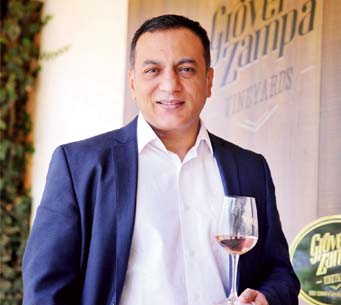
Vivek Chandramohan
What are the new developments happening at Grover Zampa?
We have fortified our capacities and we will continue to innovate and introduce new wines tailored to suit the Indian palate. Also, in the offing is investment on new land to build a state-of-the-art Winery in Bangalore. We have also expanded our international footprint by venturing into newer markets and are exploring newer opportunities. For starters, the recent investment by Grover Zampa’s stakeholders of Chateau d’Etroyes is a matter of great pride for us. We are the first Indian winery to have claimed stake at a French winery, situated in the very heart of France – Burgundy. Our unison aims to bring together the best of both the regions, by combining Burgundy’s traditions of winemaking with India’s fresh wine making approach and unique terroir. With this alliance, we hope to help Indian wine aficionados discover the elegance and sophistication of burgundies while allowing the transfer of knowledge between the nations for their mutual benefit. Furthermore, owing to quality of our wines and our incessant efforts to create unparalleled experiences, we are now associated with Alain Ducasse au Plaza Athénée, a Michelin 3-star restaurant in Paris along with many other Michelin-starred restaurants around the world. In terms of distribution, we are already exported to 22 plus countries and are working vehemently to increase this number.
Is there any new philosophy used for the production of wines?
Our wineries are operated by qualified winemaker Mathias Pelissard with expert consultation given by Michel Rolland and his team and Simon Robertson renowned viticulturist. The philosophy of production of wines in the vineyard remains very focused on adapting and fine tuning each wine during the growing season. We ensure that there is a rigid temperature control for both heating and cooling during all phases of grape processing, wine production and storage. The prime importance is given to the vineyard site. Its location, climate, soil, aspect, drainage, air movement, fog, row direction, training methods and most important the vineyardist’s desire to create quality fruit to make wines which are true reflection of their grape varietal and terroir. Broadly speaking here are the basic steps for making a wine: Harvest the grapes; Crush the grapes; Ferment the grapes into wine; Age the wine and Bottle the wine. During harvesting white grapes are usually picked first followed by red varietals. At Grover Zampa Vineyards, they are hand harvested rather than harvested by a machine. At the next stage, they are hand sorted on sorting tables to ensure we use the best grapes and then destemmed and lightly crushed by a machine. At this stage, the grapes for white wine (most frequently white grapes) are crushed by a press and the juice extracted leaving behind the skin. The juice is then put into tanks to allow the sediment to settle and then racked which means that the sediment is left behind and they are put into a new tank for fermentation. For red wine, after the red grapes are lightly crushed and destemmed they go straight into the tank for fermentation with skins included, which are instrumental in giving red wines their colour, tannins and richer flavour. Yeast is added in the tank for both red and white wines to allow fermentation to take place. Red wines are racked i.e. sedimentation removed after the fermentation has taken place. In terms of ageing the wine, there are multiple options. They can be aged for months or years and can be aged in stainless steel tanks or in a variety of different barrels e.g. French oak, American oak, used, toasted etc. The way that they are aged imparts different flavours to the wine.Once they have been aged, they are bottled. At Grover Zampa, the grapes are processed in a cooling room. We have controlled cellars equipped with modern resources such as temperature controlled tanks and our own bottling lines. This ensures that the quality remains uncompromised throughout the winemaking process. Winemaking is done in different tanks according to the different kinds of grape and the plot of land where the grape has come from in order to respect the specificity of each terroir. Most of the wine processing equipment and tanks are imported, mainly from Italy, which is known for being one of the best manufacturers of stainless steel cellar equipment.
How are the wines faring in the export market?
We have wines of various quality, styles and price points to satisfy the diverse demands of the Indian and International patrons of our wines. Our vision has always been to be known as the finest winemaker of India, which is translated into the efficacious wine making processes undertaken by us to ensure that our wines are always of top quality. Currently, our wines are exported to over 22 countries with the biggest markets being France, Japan, USA, Germany and UK. As a result of this commitment to quality, Grover Zampa Vineyards won 111 international grand awards for 13 wines, from 7 competitions, across 3 continents. In 2017 alone, Grover Zampa Vineyards won 21 awards at many prestigious events including the Decanter Asia Wine & Spirits Awards and the Hong Kong International Wines and Spirits Fair.
What is the total production premium wine per annum?
Grover Zampa has seen a tremendous growth in super premium and premium wines as people trade up within the category. This is a trend consistent with other alcohol categories where, for example in whisky, single malts have been seeing much higher growth then their cheaper blended counterparts. Super premium wines (wines priced at around `2000 and above) have seen around a 45% growth rate in the last year alone and continue to grow at a higher pace this year. The volume of premium wine in India currently stands at around 25 million bottles according to IWSR data (2015-2016), with Indian wine making up 75% of this volume although imported wines are gaining share. Within this category red wine dominates making up over 60% of the volume sold – being more suited to the rich and aromatic Indian cuisine. Unlike other alcohol categories, wine is bought equally by men and women, perhaps as a result of the widely held belief that wine is a healthier and more sophisticated option to other beverages. And contrary to popular belief the 25-34 age group are picking up wine as frequently as other age groups – again perhaps the result of wine’s prominence in popular culture. As of now, Premium wine is seeing good growth rates of around 10%, the highest growth of any alcohol category, but there are huge opportunities to increase this even further by exposing a youthful emerging middle class to wine and its many benefits. The total Wine production according to ASSOCHAM has reached 21 million litres from 17 million litres.
How do you view the Indian market’s prospects?
The wine industry in India has witnessed an upward progression in terms of both sales and popularity (between 10 and 15% per year). This growth has been fostered by factors such as the country’s growing affluence and increase in abroad travel that has invariably exposed Indians to the international wine scene. Of this growth, Grover Zampa Vineyards hold a significant share as the second largest winery in India and the most highly regarded brand in terms of qualitative, premium wines. Most recently, there has been a visible spike in growth of super-premium wines in India – those priced at around `2000 and above, as people trade up. According to our statistics, this category has grown by 45% in the last year which is great news for us as we focus mainly on premium wines and have two wines that fit in this category. Chêne Grande Reserve priced at around `1900 and Insignia – our single vineyard wine – which is priced at `6000 for a magnum and is only available to buy at our vineyards or to select private customers. While there was a slow-down last year because of the highway ban, the outlook this year seems robust and should continue on either 15% or higher growth rates overall.
Have you considered getting into brandy?
At this point we will stay with wine production.
What style of wines are most popular in India?
When talking of wines that are most popular I would say that the super premium wines are gaining popularity, rose is seeing growth as well. But when it comes to the growth in sales most of the premium wine sells in the Art Collection range. Prosecco and similar style of wines are also making inroads and growing rapidly in sparkling wine category. Keeping that in mind Grover Zampa will be launching something very unique in the sparkling wine range this year.
September 2018
Cheers for Ethanol
With oil prices on the uptake the need to blend ethanol at a faster pace is the need of the hour. A boon for sugar mills considering that India imports 20% of its oil requirements.
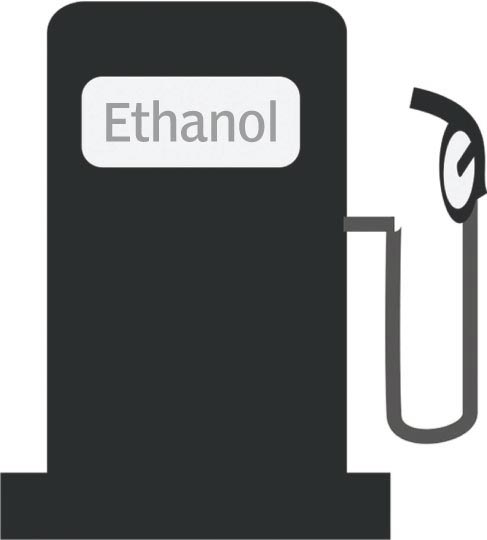
Coming to the aid of cash-starved sugar mills, the Cabinet Committee on Economic Affairs has decided to raise the prices of ethanol derived out of molasses by `2.85 a litre. The Committee decided to raise the price of ethanol derived out of C-heavy molasses to `43.70 per litre from `40.85, excluding GST and transportation charges.
Similarly, for the first time, the CCEA has fixed the price of ethanol derived from B-heavy molasses and sugarcane juice at `47.49 per litre, excluding GST and transportation charges. These prices are based on the estimated Fixed and Remunerative Price of sugarcane and will be applicable for the ethanol supply year, starting December 2018 and ending November 2019.
He also said that this will be one more step towards achieving 10% ethanol blending, for which 313 crore litres of ethanol is required, according to industry body ISMA. More ethanol blending translated into lower crude imports. The ethanol procured by Indian Oil, HPCL and Bharat Petroleum has increased from 38 crore litres in 2013-14 to an estimated 140 crore litres in 2017-18. Mills are expecting revenue realisation of over `5,000 crore from sale of ethanol to OMCs during the 2017-18 sugar season (October-September).
…………………
Alcohol-Induced Blackout
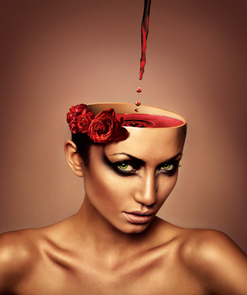
Abstract For a long time, alcohol was thought to exert a general depressant effect on the central nervous system (CNS). However, currently the consensus is that specific regions of the brain are selectively vulnerable to the acute effects of alcohol. An alcohol-induced blackout is the classic example; the subject is temporarily unable to form new long-term memories while relatively maintaining other skills such as talking or even driving. A recent study showed that alcohol can cause retrograde memory impairment, that is, blackouts due to retrieval impairments as well as those due to deficits in encoding. Alcoholic blackouts may be complete (en bloc) or partial (fragmentary) depending on severity of memory impairment. In fragmentary blackouts, cueing often aids recall. Memory impairment during acute intoxication involves dysfunction of episodic memory, a type of memory encoded with spatial and social context. Recent studies have shown that there are multiple memory systems supported by discrete brain regions, and the acute effects of alcohol on learning and memory may result from alteration of the hippocampus and related structures on a cellular level. A rapid increase in blood alcohol concentration (BAC) is most consistently associated with the likelihood of a blackout. However, not all subjects experience blackouts, implying that genetic factors play a role in determining CNS vulnerability to the effects of alcohol. This factor may predispose an individual to alcoholism, as altered memory function during intoxication may affect an individual’s alcohol expectancy; one may perceive positive aspects of intoxication while unintentionally ignoring the negative aspects. Extensive research on memory and learning as well as findings related to the acute effects of alcohol on the brain may elucidate the mechanisms and impact associated with the alcohol-induced blackout. Keywords: blackout, alcohol, memory
1. Introduction Alcohol is a threat to global health, accounting for 4% of the global health burden, a proportion that is comparable to tobacco and hypertension [1]. Dysfunctions of multiple organ systems brought on by chronic alcohol use, including the brain, have long been the focus of medical concern, and are well documented in the public health literature. Nevertheless, alcohol continues to be a part of human culture. Acute effects of alcohol intoxication are a common, often voluntary experience and not necessarily considered a problem in itself. The alcoholic blackout, however, is one phenomenon of acute alcohol intoxication that merits special attention. Initial research in the 1950s reported that such blackouts are a hallmark of progressive alcoholism [2,3]. However, further research has proved otherwise, and blackouts are no longer considered as a signal of irreversible alcoholism [4]. Perhaps because the majority of people experiencing an alcoholic blackout are not clinically alcohol dependent, alcoholic blackouts may have been relatively neglected in terms of treatment intervention. Rather, legal matters have been the focus of cases where violations of the law are committed under intoxicated, amnesic states. The mechanisms of an alcohol-induced blackout may be crucial in understanding its clinical implications. For a long time the effect of alcohol was thought to be a generalized depression of neural activity causing global impairment of cognitive, psychological, and behavioral domains [5–7]. An alcoholic blackout was perceived as the extreme manifestation of this effect. However, the blackout, characterized by amnesia during episodes of intoxication where the subject is conscious and able to carry on conversations or even drive a vehicle [8,9], is a manifestation of the selective effects of alcohol on specific brain systems. Previously, ethanol, a short chain lipid soluble compound, was thought to affect cells by a nonspecific lipid membrane disordering effect [5,6,10]. However, it is increasingly evident that alcohol interacts with specific neurotransmitter receptors, and current consensus is that specific regions of the brain are selectively vulnerable to acute effects of alcohol [5,10–15]. We need to make the memory staging terms clear as follows: immediate memory is also termed acquisition memory; short-term is also called retention memory; recent is called also consolidation memory and finally remote is referred to as also retrieval memory. Progress has been made in elucidating the mechanism of various memory systems and how they are affected by alcohol. There is increasing evidence that repeated alcoholic blackouts actually serve as a mechanism that facilitates alcoholism [2,16]. In this paper we aim to describe and discuss the alcoholic blackout to improve the understanding of this phenomenon and recognize its many faceted implications in medical practice and public health.
2.Methods The PubMed database was searched (1965 to 2009) for epidemiological, pathophysiological, and social studies related to the alcoholic blackout, using the terms blackout, alcohol and memory, episodic memory, hippocampus and alcohol, and alcohol and the nervous system. The bibliographies of selected articles were used to extend the search. Articles were screened for their relevance to the specific topic of alcoholic blackout and related memory deficits on the basis of the title and abstract.
3.Clinical and Physiological Characteristics 3.1. Definition An alcoholic blackout is amnesia for the events of any part of a drinking episode without loss of consciousness. It is characterized by memory impairment during intoxication in the relative absence of other skill deficits. It is not to be confused with ‘passing out’ [9]. Early documentation from Alcoholics Anonymous describes a variety of blackout behavior, especially in the en-bloc type, which includes driving for long distances or carrying on apparently normal conversations at parties. Subjects often report waking in strange places without any memory of how they got there. Criminal acts including murder, have been reported [17]. Although some have criticized these extremes, stating that such behavior is “exaggerated and a form of selective memory or denial to avoid guilt and confrontation over antisocial behavior brought on by drinking” [9], it nevertheless portrays the selective impairment of memory during an alcohol-induced blackout.
3.2. Types of Alcoholic Blackouts An alcoholic blackout may be complete (en-bloc) or partial (fragmentary, or grayout) [2,9]. An en bloc blackout is complete amnesia for significant events otherwise memorable under usual circumstances. The defining characteristic of a complete blackout is that memory loss is permanent and cannot be recalled under any circumstances. Fragmentary blackouts occur more frequently [18,19]. In fragmentary blackouts, recall is usually possible and can be aided by cueing. Although initially the subject may be unaware that memory is missing, reminders usually help the subject remember forgotten events [9]. It is, however, difficult for investigators to be totally accurate because people may often fail to remember having a blackout, or do not attend to all circumstances in which they might have had a blackout, particularly fragmentary blackouts. Therefore, metamemory deficit is an issue in this type of research.
4.Epidemiology A high frequency and volume of alcohol use is the single factor most closely related to experiencing blackouts [7]. In contrast to the older misconception that blackouts are an unlikely consequence of heavy drinking in nonalcoholics, anyone who drinks too much and too fast may experience a blackout [4]. For instance, 35% of trainees in a large pediatric residency program had reported experiencing at least one blackout [20]. In addition, 33% of first year medical students interviewed in another study acknowledged experiencing at least one blackout [8]. A survey of 2,076 Finnish males concluded that 35% experienced at least one blackout in the year before the survey [21]. Cultural and socioeconomic backgrounds are associated factors. The college campus is one subculture where excessive drinking is tolerated, if not encouraged. In a survey of 772 undergraduates, approximately one-half of those that had ever consumed alcohol reported experiencing at least one blackout during their lives, and 40% experienced one the year before the survey [22]. However in a four year follow up of young blackout drinkers, only 32% of respondents that were experiencing blackouts in the initial survey continued to experience them four years later. Alcoholic blackouts in this group appeared to have resolved spontaneously when the subjects graduated college, got married, or successfully entered the adult work force. Spontaneous resolution of blackout drinking appears to result from an interaction between informal support and objective social conditions such as full-time employment and a positive financial situation. To a certain extent, life transitional changes such as assuming adult roles appear to be a strong influence on the process of disengagement from problem drinking. Those who continued to experience blackouts after four years were male, comparatively young, unmarried, and with a lower socioeconomic status. The most salient predictor of chronic blackout drinking was the number of alcoholic relatives [9].
4.1. Risk Factors Although a high blood alcohol concentration is required to induce a blackout, many drinkers reminisce that they have drank much more and not had a blackout [7]. A rapid rate of increase in blood alcohol concentration (BAC) is most consistently associated with the occurrence of an alcoholic blackout [7,23,24]. Therefore, gulping drinks, drinking on an empty stomach, or drinking liquor (opposed to beer) are risk factors of an alcoholic blackout [7]. However, not all subjects who drink rapidly and excessively experience blackouts, suggesting that there are individual that are genetically more vulnerable to alcohol-induced memory impairment [2,7,25]. Alcohol-induced blackouts are not necessarily the result of an underlying cognitive dysfunction; in a study of fragmentary blackouts, there was no baseline memory differences among the subjects that did or did not experience an alcohol-induced blackout [2]. This means that a baseline memory function does not seem a risk factor of blackouts.
5. Pathophysiology A blackout is the result of alcohol-induced disruption of memory formation. The formation of memory involves the following processes: encoding, the initial registration and interpretation of stimuli; storage, consolidation and maintenance of encoded stimuli; and retrieval, which is the search and recovery of stored stimuli [2]. Alcohol has its greatest effects on encoding [26]. Short-term memory, which functions over a period of seconds, is relatively spared even during an en-bloc blackout, and recall of long-term memory, which applies on the scale of days to years, established before intoxication is also maintained [7]. Amnesia for events during intoxication involves impairment of episodic memory [3,7]. Episodic memory, by definition, includes the time, place, and other interrelated circumstances in which the event occurred. This contextual information is a prerequisite for formation of episodic memories [27,28]. Alcohol’s effect on encoding may disrupt the processing of context for the formation of an episodic memory. Because the episode was encoded with faulty context, free recall of this memory may be particularly difficult [29,30] or, depending on the degree of encoding impairment, even impossible, as in the case of en-bloc blackouts. In a fragmentary blackout, a striking feature is that cueing aids recall. Reminding a subject of events during the blackout often brings on more forgotten memories [4]. Such reminders, or cues, may provide contextual information during which a memory was formed, giving access to memory that was deficiently encoded.
The cellular mechanism by which a context is generated has been partially elucidated by observation of ‘place cells’ in rodents. Place cells are cells in the rodent brain which fire when the animal is in a particular location in the environment [31]. These location-specific cells ultimately create a spatial map in the brain, serving as a framework for event memories created in that environment. These cells are found in the CA1 pyramidal cell layer of the hippocampus. Alcohol profoundly suppresses activity of these cells. The dose-dependent suppression of CA1 pyramidal cells is consistent with dose-dependent effects of alcohol on episodic memory formation [28,32]. Evidence suggests that cognitive abilities mediated by the hippocampus might be particularly sensitive to the effects of moderate doses of alcohol [32]. In humans, hippocampal damage results in profound impairments in episodic memory with relative preservation of other functions in a way that is remarkably similar to an episode of an alcoholic blackout [10,31,33].
The molecular mechanisms of the effects of alcohol on the hippocampus are not clear. However, one leading candidate for a cellular substrate of memory formation is long-term potentiation (LTP), which is the establishment of long lasting heightened responsiveness to signals from other cells [7,34,35]. Alcohol inhibits establishment of LTP by potently antagonizing N-methyl-D-aspartate (NMDA) receptor activity [32,36,37]. The NMDA receptor is necessary for LTP induction in area CA1 of the hippocampus. Ethanol’s effect on LTP in area CA1 of the hippocampus is thought to involve both inhibition of the NMDA receptor and potentiation of the ?-aminobutyric acid A (GABAA) receptor transmission, which leads indirectly to further NMDA receptor inhibition [7,35,36].
Theories proposing that alcohol-related amnesia is a result of state-dependent effects of alcohol suggest that forgotten memories of events during intoxication may be recalled by returning to that intoxicated state [18]. However, in a study on fragmentary blackouts, participants that experienced fragmentary blackouts exhibited poor recall even after returning to an intoxicated state [38]. Although alcohol may act as a subjective, physiologic cue [2], a much more influential effect is its impairment of encoding [7,38].
Nevertheless, memory formation and retrieval are also influenced by other cognitive factors such as attention and motivation [39]. Some studies suggest that alcohol may have detrimental effects on certain aspects of retrieval [2]. A recent animal research paper showed that alcohol can cause retrograde memory impairments. Rats were allowed to learn while sober, but if that learning was followed by a very high dose of alcohol, then the next day or two they showed severe memory impairment. This suggests that blackouts are not always due to deficits in encoding, attention or other memory-related processes but also can be due to consolidation or retrieval impairments. The implication is that, for example, a person might be sober during an episode such as a conversation with someone, but then if this is followed by binge drinking this conversation might not be remembered even though there was no alcohol on board at the time. This retrograde amnesia was found to be prevented by caffeine and related agents, implicating the adenosine A2A receptor and phosphodiesterase [40]. The inconsistent study results underscore the need for further investigation to elucidate the role of alcohol in the development of blackouts.
6. Treatment Implications Conventionally, an alcohol-induced blackout has been thought to be an essential early warning sign of problematic drinking, occurring very rarely in non-alcoholics. Previously, blackouts were ranked among the top three indicators of alcoholism, its course remaining relatively stable over time [3]. Although now it is clear that blackouts are not limited to alcoholics, it is a strong indicator of rapid and excessive drinking. A great majority of alcoholics experience blackouts during the early phase of addiction [41]. Even in young social drinkers, those that experience blackouts are characterized by more days of drinking, frequent heavy drinking, and a greater number of drinks per day. The influence of heavy drinking on the blackout incidence is even more compelling considering the fact that heavy drinkers are known to minimize self-reported estimates of drinking [9].
Although the alcohol-induced blackout itself may not be an indicator of progressive alcohol dependence, the way in which an individual views the experience of a blackout may be influential in determining future drinking behavior. Social learning theory implies that drinking patterns are maintained by biased beliefs about alcohol and one’s own behavior [2,42,43]. Among college students that experienced alcoholic blackouts, the majority was frightened by the amnesia and as a result decreased their intake of alcohol. Failure to appropriately modify drinking behavior after a blackout, in other words, chronic blackouts, may be a serious sign of alcoholism [4]. One’s drinking experience should play a role in determining one’s alcohol expectancy, but limited recall of events associated with intoxication may confuse one’s bases for outcome expectancies [2]. Alcohol’s initial effects are euphoria, which is then followed by more sedative effects [2,44,45]. It is reported that positive effects of alcohol occur more reliably among heavy drinkers [46] and that these positive effects occur at lower BAC [44]. Accordingly, positive expectancies are generally endorsed more strongly by heavy drinkers [47]. The variant aldehyde dehydrogenase 2 gene allele (ALDH2*2) is well known to be associated with negative physiological responses in normal samples in past research. A recent study showed, however, that the psychological expectancies associated with drinking are more positive and less negative in persons with alcoholism that have the ALDH2*1/*2 genotype [48]. This result implies that the positive expectancies associated with drinking alcohol appear to override the usual discomfort or negative effects associated with protection against drinking alcohol. Blackouts are associated with rising BAC, and recall of a drinking episode may reflect the initial positive effects better than the later negative effects. Those experiencing fragmentary blackouts have been reported to perceive a greater likelihood of positive alcohol effects compared to those who have not experienced blackouts, indicating that memory impairment during intoxication may produce a cognitive bias with regard to the alcohol associated experiences.
In addition, those reporting en bloc blackouts had strong positive alcohol expectancies [2]. As mentioned above, the alcoholic blackout is a sign of brain dysfunction that results in memory impairment. In order to prevent alcohol-induced blackouts, the following is recommended: drink alcohol slowly, drink modestly, drink infrequently, drink with side dishes, and abstinence or moderation in drinking is especially important in high-risk groups, that is, persons with a large number of alcoholic relatives. Since alcoholic blackouts occur early in the course of disease and the blackout itself may act to facilitate problematic drinking resulting in another blackout, psychoeducation targeting episodes of alcoholic blackouts may be effective in preventing further episodes and the evolution to full-blown alcoholism.
Acknowledgments This study was supported by a grant of the Korea Healthcare technology R&D Project, Ministry for Health, Welfare & Family Affairs, Republic of Korea (5-2009-A0048-00060).
Dice loaded in favour of Kasino Bar
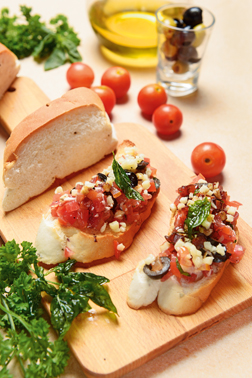
With an array of experiential restaurants making a mark in today’s time, it takes more for a meal than just good taste to stand out. Keeping the city’s nightlife in mind, Malad’s newest addition — Kasino Bar — takes pride in being India’s first casino themed restaurant and lounge. What makes this restaurant truly one of its kind is the eclectic flow of vegetarian and vegan dishes that are specially curated to suit the contemporary tastes of the public today. We have a very global cuisine, says Anki Talati, Director, Kasino Bars. Patrons can relish a round of drinks as well as carefully concocted cocktails & mocktails to accompany the continental fare in store at Kasino Bar. The 225 cover restaurant boasts of its voguish, dark themed interiors, that incorporates elements of hues and blues along with subtle neon lights to suit a crowd of all ages. Strategically located in an upcoming locality in Malad, Kasino Bar’s chic, snazzy vibe brings together a metropolitan crowd unlike its competitors in the vicinity. An idiosyncratic feature of Kasino Bar allows guests to indulge in invigorating Kasino Virtual Games, that give you the look at feel of playing at a real casino bar. Patrons participating can win discounts that include upto 100% cash-backs, fun goodies and so much more that’s on their list. They get a real feel of Casinos which are generally there on week days. Themes like Arabian nights and many otheres also draw in the crowds and weekends are crowded so the big spacious outlet has no room for roulettes, says Talati. The big open windows is also a delight for those who like to watch the sunset. Ideal for a night out with friends or a game night with family, Kasino Bar’s interactive feature makes sure nobody loses, and you don’t go home with a frown! Patrons can revisit and keep note of their score with its newly introduced loyalty memberships as well. So, unwind and indulge in a round of roulette along with a plethora of sumptuous grub at your disposal — Kasino Bar promises to be an experience unlike any other, and will have you returning with a smile on your face for yet another game next time around! Started with an investment of `3 crore, we plan to have 10 more outlets. The plan is to open two or three more and then take the franchising route, says Talati.
For celebrating 50 years with Carlsberg, a painted portrait
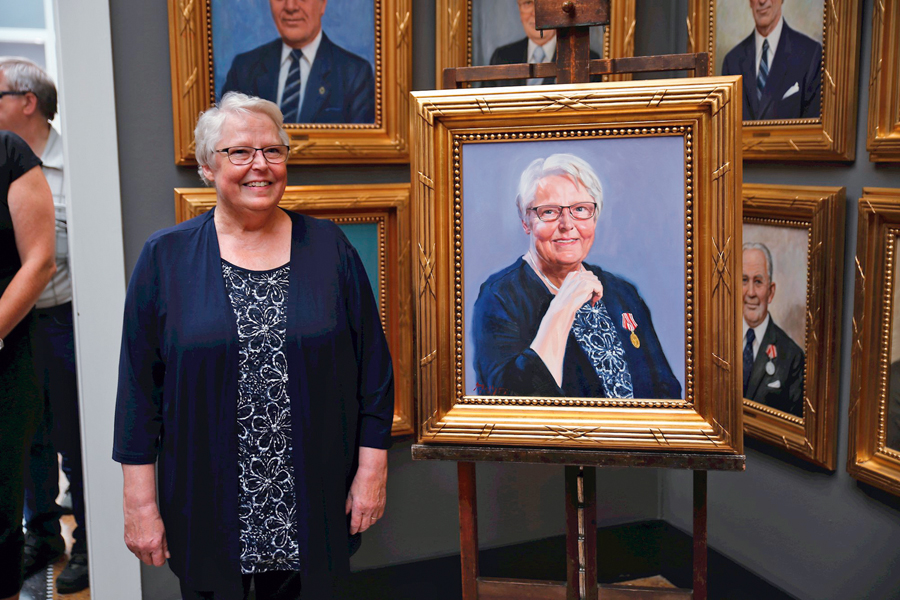
On August 1, Karin Dalgaard experienced something reserved for the few. 50 years at the same company. Recently celebrated at the Carlsberg Museum where Karin’s anniversary was crowned with a handpainted portrait.
“I didn’t walk through the doors at Carlsberg at the age of 16 and think this is where I would spend the rest of my life. But after my time as a trainee, where I was moved around in eight different departments, I got a job in our export department. I enjoyed it there and so the years passed by one by one,” says Karin.
One year has over time turned into 50, and so Carlsberg celebrated Karin with a reception at the Carlsberg museum. Carlsberg has a long-standing tradition of honouring jubilees who celebrate 50 years at Carlsberg by hanging their portrait in the museum. Yesterday, Karin’s portrait, painted by Danish artist Mikael Melbye, was unveiled as friends, family and, last but not least, colleagues gathered at the Carlsberg museum to toast to and congratulate Karin.
Speaking at the ceremony in Copenhagen, Karin said, “I’m honoured, overwhelmed and humbled by today’s celebration and the recognition from Carlsberg and my colleagues. For the 50 years I have been looking at these portraits, I never imagined that my face would one day join them. They’ve always been special to me, so to see myself on the wall feels almost surreal.”
The tradition itself started with Carl Jacobsen, son of brewer J.C. Jacobsen, who ordered paintings of those retiring employees that he especially valued. Characterising these employees was the fact that they had been employed by him most of their working life. Altogether, Carl Jacobsen had 5 paintings of former employees done.
The tradition was brought up again in 1928, but this time the paintings were ordered to honour jubilees, who could celebrate 50 years with Carlsberg. The majority of jubilees are men, with all sorts of professions. Karin is the 4th woman in Carlsberg’s 171 years history that reach the 50 years jubilee, and the last time we had a 50 years jubilee was back in 2009.


